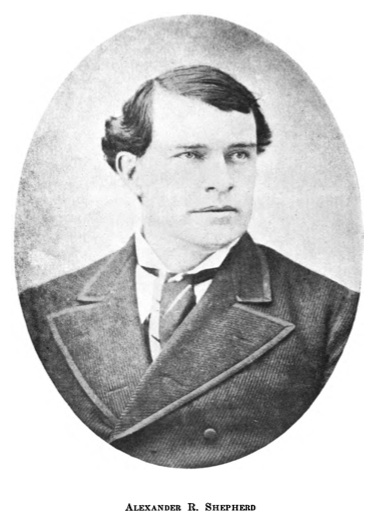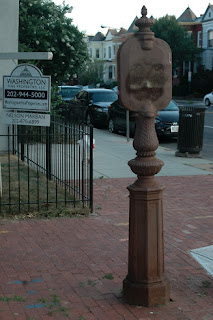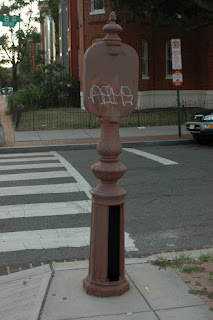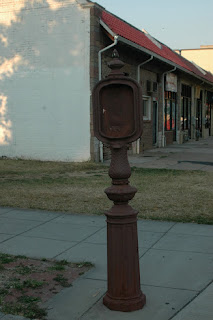Shaw’s Historic Fire and Police Call Boxes
a project of Shaw Main Streets, Inc.
Call Box 1 - 10th and N
Location: Northeast corner of intersection of Tenth and N Streets, NW
Style: Police
Condition: Missing access panel
Follow-Up:
Subject of Plaque: When Was Shaw's First Development Boom?
Draft Text of vignette:
The earliest buildings in the Shaw neighborhood pre-date the civil war. After the war, major development was spurred in part by the actions of Alexander “Boss” Shepherd. Shepherd led the Board of Public Works in a massive public services campaign in the 1870s that brought graded streets, water and sewer service, sidewalks, streetlamps, and trees to many areas of the city. Shepherd lived nearby at 1125 10th Street beginning in 1871.
One example of the area’s increased density and prestige is the classical revival styled apartment building known as "The Atlantic" right behind you at 1305 10th Street. It contains twenty four units and was designed by Albert H. Beers in 1911. Mr. Beers was one of Washington's most prolific architects. He worked most closely with developer, Harry Wardman, designing innumerable rowhouses and apartment buildings.
Sources for Text: http://ia700502.us.archive.org/16/items/apartmentbuildin00harr/apartmentbuildin00harr.pdf
and http://planning.dc.gov/OP/HP/District%20Brochure%20pdfs%204.1.2/Shaw_Brochure.pdf
and http://planning.dc.gov/OP/HP/District%20Brochure%20pdfs%204.1.2/Shaw_Brochure.pdf
Image for vignette: Image of Alexander Boss Shephered
http://en.wikipedia.org/wiki/File:Alexander-Robey-Shepherd.jpg
Follow-Up: Determine/Obtain image
Image of current condition (06/2012)
Call Box 2 - 10th and N
Location: Northeast corner of intersection of Tenth and N Streets, NW
Style: Antique Fire
Condition: No missing parts
Subject of Plaque: What did we do before cell phones?
Draft Text:
Long before the era of smart phones -- and even before the era of house and pay phones -- emergency communications throughout Washington were conducted via call boxes like the ones you stand before right now. These call boxes were installed throughout the capital starting in the 1860s, and some were cast atop former gas street lamp bases.
Police call boxes were distinct in design from fire call boxes and were painted blue. The call box to your right is an example of a police call box. Fire call boxes were painted red and were either quite fanciful like the one you are looking at now or had a house-shaped call box on top of their bases.
Emergency call boxes began to become obsolete with the introduction of the 911 emergency call system in the 1970s, and the working electronic components were all removed by 1995, leaving the call boxes and bases behind. Yet the call boxes remained.
In 2012, historic preservation and commercial revitalization nonprofit Shaw Main Streets, Inc. engaged community artists to help transform these iron relics into artistic and informational points of interest throughout the neighborhood. For more information, visit www.shawmainstreets.org/callbox.
Image for vignette: Photo of a callbox in use? For example: http://www.shorpy.com/node/4601
Follow-Up:
Above image of current condition (06/2012)
Call Box 3 - 8th and N
Location: Northeast corner of intersection of Eighth and N Streets, NW
Style: Modern Fire
Condition: Top half missing; Bottom half in tact -- no missing access panel
Subject of Plaque: Monsignor Mundell, the Shepard of Shaw
Draft Title: Who was the "Shepherd of Shaw"?
Draft Text: Reverend Monsignor J. Joshua Mundell was pastor of Immaculate Conception Catholic Church from 1964 to 2001. He was widely known and praised by his peers, parishioners and other D.C. residents for his devotion to the poor and needy. His commitment to the parish school, which he reopened in 1964, and the building of Immaculate Conception Apartments won him the title of the "Shepherd of Shaw." Father Mundell befriended men and women of every religious affiliation and sought to make them always at home in the Catholic Church. He attended Georgetown University and Mount Saint Mary's Seminary and was award each school's highest honors. He served in the United States National Guard as Chaplain, retiring with the rank of Major.
Source for Text: http://www.immaculateconceptionchurchdc.org/history_pastors.php
Image for vignette: Monsignor Mundell (source - Immaculate Conception Church?)
Follow-up: Determine/Obtain Image; contact DDOT for spare modern fire top
Image of current condition (06/2012)
Call Box 4 - 6th and N
 |
| Taken in 06/2012 - missing access panel |
 |
| Taken in 06/2012 |
 |
| Image from 10/4/2009 showing what the box used to look like with top half |
Location: Southwest corner of intersection of Sixth and N Streets, NW
Style: Police
Condition: Top half missing; access panel missing from bottom half
Subject of Plaque: Ephesus 7th Day Adventist Colored Church at 1240 6th Street –National Dairy 612 O Street 1875-1927 Freedman’s Alley - First Rising Mt Zion
Draft Text:
Image for vignette: TBD
Follow-Up: Research/Draft text; deterime/obtain image
Opportunity for double sided insert!!!
Call Box 5 - 7th and P
Location: Southeast corner of intersection of Seventh and P Streets, NW
Style: Modern Fire
Condition: Missing access panel
Subject of Plaque: Broadway Theater 1515 7th (1921) – Salvation Army 1501 7th St. (organized right after WWI – closed 1950) Building burned in 1968 riots – Freedman’s Bureau’s Wisehall Barrack Sabbeth School - Rockville Turnpike (7th Street) and Street Car lines [Washington and Georgetown Railroad line established in 1862 and ran from Florida to the Potomac River] were horse drawn / Bread for the City (est 1994 by Emmaus Fellowship) (Barker Lumber Warehouse – 1525 7th St) O Street Market built 1881 - Fruit and Tree Nursery 1852-1872 at site of Kennedy Rec Center
Draft Text:
Image for vignette: TBD
Follow-Up: Research/Draft text; determine/obtain image; contact DDOT for missing part or have fabricated.
Opportunity for Double Sided Plaque
Images of current condition (06/2012
Call Box 6 - 8th and Q
Location: Northeast corner of intersection of Eighth and Q Streets, NW
Style: Modern Fire
Condition: Missing altogether
Follow-Up:
Subject of Plaque: Asa Philip Randolf - 817 QSt
Vignette Title: A Neighbor, A Leader
Draft Text:
History on Every Corner
There’s history on every corner of the Shaw neighborhood, on every street. The storefront at 1600 8th Street, NW, was occupied by a carpentry shop in the 1910s. Later, a succession of churches rented that space. In 1939, Elijah Mohammad (1897-1975) briefly preached there until moving to 1527 9th Street, NW, to establish what became the Nation of Islam’s Temple #4.
Across the street, at 1554 8th Street, NW, the Archdiocese of Washington ran the Immaculate Conception Academy for Girls until the early 1950s. Fides Neighborhood House, a Roman Catholic settlement house, was there until 1973. The Ujamaa School moved there in 1978.
And at 817 Q Street, NW, the International Brotherhood of Sleeping Car Porters had their Washington office from 1943 to 1978. From there, union president Asa Philip Randolph helped plan the 1963 March on Washington for Jobs and Freedom.
Text Source: Alex Padro
Image: Asa Philip Randolph (1889-1979)
Source: http://en.wikipedia.org/wiki/File:A._Philip_Randolph_1963_NYWTS.jpg
Follow-up: Obtian/verify photograph rights; approve text; contact DDOT for missing modern fire style callbox and installation.
Image of current condition (06/2012)
Call Box 7 - 7th, R and Rhode Island
Location: Seventh and R Streets and Rhode Island Avenue, NW (in front of the Watha T Daniel/Shaw Neighborhood Library
Style: Modern Fire
Color Scheme: Red/Orange
Condition: Missing Access Panel
Subject of Plaque: Who was Shaw's neighborhood library named for?
Draft Text:
Watha T. Daniel was a Shaw neighborhood resident and activist who lived from 1911 to 1973. A master plumber by training, in 1967 he became the first African-American appointed to the DC Plumbing Board.
Mr. Daniel was deeply engaged in the livelihood of the Shaw neighborhood and served on numerous boards and commissions. He served on the DC Board of Education's Board of Examiners for Trade Instructors. He was also chairman of the Citizens Housing Advisory Council. Mayor Walter E. Washington appointed Mr. Daniel to the Mayor's Advisory Committee on Health and the District's LEAA Criminal Justice Advisory Committee. In the 1960s Mr. Daniel was elected to the Citizens Advisory Committee of the Shaw Neighborhood Development Center, and he became a charter member of the Model Inner City Community Organization (MICCO). Later becoming vice-president of MICCO. He also served as the first chairman of the DC Model Cities Commission, an urban renewal program, between 1968 and 1972.
On September 27, 1975 the DC Public Library opened the Watha T. Daniel/Shaw Neighborhood Library at 7th St. and Rhode Island Ave., NW. The original library bearing Mr. Daniel's name was of the Brutalist architectural style. It was razed in 2008 and replaced by a modern ne, award winning library on the same site that opened in 2010.
Secure Image of Watha T. Daniel
Image of current condition (6/2012)
Call Box 8 - 6th and R
Location: Southeast corner of intersection of Sixth and R Streets, NW
Style: Police
Condition: Missing access panel
Subject of Plaque: Education - Morse School/Africare Alexander Graham Bell School (Adaptive Reuse)
Draft Text: TBD
Image: TBD
Follow-Up: Research/draft text; Identify/Obtain image; contact DDOT for missing part
Image of current condition (06/2012)
Call Box 9 - 6th and S
 |
| Taken in 06/2012 |
 |
| Taken in 06/2012 |
 |
| Taken in 06/2012 |
 |
| Taken in 06/2012 |
 |
| Image from 2009; Spire Missing as of 2012 |
Location: Northwest corner of intersection of Sixth and S Streets, NW
Style: Antique Fire
Condition: Missing top spire and access panel
Paint Scheme: Red
Subject of Plaque: Ever wonder where Hostess Cakes were made?
Draft Text:
A few feet to the east of here at 641 S Street, NW, is an old bakery known to many as "The Wonderbread Factory." Long-time residents of the neighborhood recall fondly the sweet smells that once emanated from the bakery, which at one point produced approximately 100,000 Hostess Cakes daily.
Dorsch's White Cross Bakery, also known as the Wonder Bread Factory, is a complex of historic structures located in the Shaw neighborhood of Washington, D.C. It was entered in the D.C. Inventory of Historic Sites in 2011 and listed on the National Register of Historic Places in 2012.
Peter Michael Dorsch (1878-1959), was a Washington, DC native who established the White Cross Bakery in 1904. He moved the business to S Street in 1913. The buildings that front S Street, NW were built in 1915 and 1922. They were designed by different architects, but they are composed of similar materials, treatment and details. They features elements of the American Craftsman style. White terra cotta tile crosses in the center pediments identify the building with White Cross Bakery. Plans are underway to redevelop the facility into a mix of office and retail uses.
Continental Bakery, parent company of the Wonder Bread brand, purchased White Cross Bakery. Continental operated a bakery at 641 S Street -- and another bakery nearby on 7th St. -- until 1988, when it closed both facilities. The building remained mostly vacant for years following.
In 2012, Douglas Development rehabilitated the building into commercial space.
Sources: http://jscholarship.library.jhu.edu:8080/bitstream/handle/1774.2/35987/Hockensmith_Development%20Proposal%20For%20Wonder%20Bread%20Condominium,%20641%20S%20Street%20NW,%20Washing%20DC_2011_Ely.pdf?sequence=1
http://en.wikipedia.org/wiki/Dorsch's_White_Cross_Bakery
Image: TBD
Hostess Cake Ad?
Two sided plaque opportunity!
Follow-Up: Research/Draft text; identify/obtain image;
Opportunity for 2 sided plaque
Call Box 10 - 8th and T
Location: Northeast corner of intersection of Eighth and T Streets, NW
Style: Police
Condition: Missing access panel
Subject of Plaque: Education/Odd Fellows Lodge at 9th and T
Draft Text: TBD
Source http://www.princeofpetworth.com/2012/06/then-and-now-by-the-house-history-man-grand-united-order-of-odd-fellows-guoof-building/
Image for vignette: http://www.princeofpetworth.com/2012/06/then-and-now-by-the-house-history-man-grand-united-order-of-odd-fellows-guoof-building/
Follow-Up: Research/Draft text; Identify/Obtain image; Contact DDOT for missing access panel.
Images of current condition (06/2012)
Call Box 11 - 9th and T
Location: Southeast corner of intersection of Ninth and S Streets, NW
Style: Antique Fire
Color Scheme: Red
Condition: Top half missing; missing access panel
Subject of Plaque: Walter Fauntroy
Draft Text:
New Bethel Baptist Church has been worshipping at 9th at S Streets since 1915. In addition to its spiritual contributions to the neighborhood, the congregation and its leadership have played a vital role in the neighborhood’s stability, revitalization, and access to affordable housing.
Under the leadership of its third pastor, Reverend Walter E. Fauntroy, the New Bethel Housing Corporation was formed in 1958. In 1973, the nearby Foster House Apartment Building was constructed on the comer of 9th Street and Rhode Island Avenue N.W. This 76-unit complex continues to be a cornerstone within the community as it provides housing to low and moderate income residents in Shaw.
New Bethel was at the forefront of significant change locally and nationwide during Rev. Fauntroy's tenure. This includes the design and implementation of the Shaw Urban Renewal Project, engagement in civil and voting rights campaigns with Martin Luther King, Jr., the effort to win Home Rule for residents of the District of Columbia, and numerous worldwide humanitarian campaigns during Rev. Fauntroy's tenure as a Member of the United States House of Representatives.
Image: Reverend Fauntroy
Follow-Up: Identify/obtain image; contact DDOT to secure missing top half of callbox (or replacement antique fire callbox)
Image of current condition (06/2012)
Call Box 12 - 9th and Rhode Island
Location: Rhode Island Avenue between Q and Ninth Streets, NW
Style: Police
Color Scheme: Blue
Condition: Missing access panel and top finial
Subject of Plaque: Phillis Wheatley YWCA
Draft Text:
Who was Phyllis Wheatley and Why is There a “Y” Named for Her?
When a poem by 14-year-old Phyllis Wheatley appeared in a newspaper in 1767, the young slave owned by Boston tailor John Wheatley became the first black woman to have her poetry published. Phyllis (sometimes written ‘Phillis’) traveled to London in 1773, where a book of her poetry, Poems on Various Subjects, Religious and Moral, was published, bringing her international attention. Freed that same year, Phyllis Wheatley died in 1784.
In 1905, a Young Women’s Christian Association chapter was established in Washington to offer lodging to young African American women arriving in Washington seeking employment. After being housed at two other locations, the building across Rhode Island Avenue from this park was constructed in 1920. In 1923, the institution’s name was changed to the Phyllis Wheatley YWCA to honor the first African American poet.
Image: LC-USZC4-5316
http://www.loc.gov/pictures/resource/ppmsca.02947/
Follow-Up: Obtain image; Contact DDOT for missing access panel and top finial.
Image of current condition (02/2012)
Call Box 13 -- 10th and Rhode Island
Location: Tenth Street and Rhode Island Avenue, NW
Style: Modern Fire
Color Scheme: Red
Condition: Good.
Subject of Plaque: Urban Renewal/How Shaw Got Its name
Draft Text:
How did Shaw get its name?
The Shaw neighborhood’s namesake is Colonel Robert Gould Shaw (1837-1863), a white US Army officer who led the African American Massachusetts 54th Regiment during the Civil War.
The Shaw name was introduced in the neighborhood in 1928, when McKinley High School (a few blocks away at 7th Street, NW and Rhode Island Avenue, NW), formerly part of the city’s white school system, became a black school named in honor of the Civil War hero.
In 1966, the school’s attendance boundaries were used to define "The Shaw School Urban Renewal Area," and a neighborhood name that had been used informally by residents was put on the map. The plan was adopted in part as a plan to guide reconstruction of the neighborhood after the 1968 riots.
In 1977, a new Shaw Junior High School opened across the street from where you stand in the 900 block of Rhode Island Avenue.
In 1966, the school’s attendance boundaries were used to define "The Shaw School Urban Renewal Area," and a neighborhood name that had been used informally by residents was put on the map. The plan was adopted in part as a plan to guide reconstruction of the neighborhood after the 1968 riots.
In 1977, a new Shaw Junior High School opened across the street from where you stand in the 900 block of Rhode Island Avenue.
LOT 14022, no. 14 [P&P] - Colonel Robert Gould Shaw
Follow-Up: Identify/obtain image.
Image of current condition (06/2012)
Subscribe to:
Posts (Atom)





























